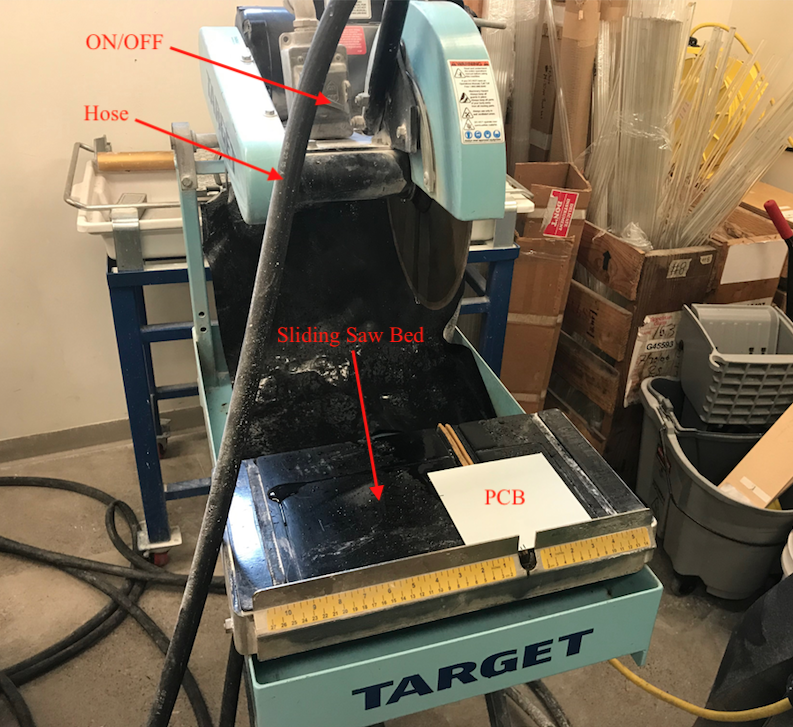Difference between revisions of "Cutting the Board"
Aplstudent (talk | contribs) |
Aplstudent (talk | contribs) |
||
| Line 14: | Line 14: | ||
This makes using a diamond blade saw your best option. While there is a small diamond blade saw in the APL, I strongly recommend using the one in the craft center's Glass Shop (which is free for students to use). The glass shop is very well ventilated (make sure the fume hood in the room is turned on) and the saw blade has a source of running water that flows over the blade as it cuts, this is ideal for cutting glass/fiberglass because the water traps silica dust during the cut. Lastly, the saw in the craft center has a sliding bed for you to rest your PCB on, which will ensure a straight cut. Below is a labeled picture of the diamond blade saw I recommend you use: | This makes using a diamond blade saw your best option. While there is a small diamond blade saw in the APL, I strongly recommend using the one in the craft center's Glass Shop (which is free for students to use). The glass shop is very well ventilated (make sure the fume hood in the room is turned on) and the saw blade has a source of running water that flows over the blade as it cuts, this is ideal for cutting glass/fiberglass because the water traps silica dust during the cut. Lastly, the saw in the craft center has a sliding bed for you to rest your PCB on, which will ensure a straight cut. Below is a labeled picture of the diamond blade saw I recommend you use: | ||
| − | [[File:]] | + | [[File:Diamond Saw.png]] |
Revision as of 14:02, 2 March 2019
Our blank boards are 4x6 or 6x6 inches; There may be smaller pieces that can be used as well. If you need to cut a board, use the hacksaw. NEVER use the paper shear - It will not only cut uncleanly (destroying a half cm wide region on both sides of the blade), more importantly it will permanently warp the board and make it nearly impossible to get a uniform close contact between the artwork film and the board. If the board does not lie flat against the film print then the exposure will be fuzzy and the image transfer will lack the high resolution necessary.
Before cutting the board, mark the white protective tape using a pen and straight-edge, then clamp the board in the yellow rubbery gentle-jaws in the vise and saw horizontally.
Once the board is cut to size, the artwork is ready in the UV chamber (READ AHEAD!), and all that remains is to slip the copper board between the films, peel the protective layer off. If the board was cut, the edges will have sharp copper sticking off them. Not only will this prevent the film from lying conformally flat against the board, it will also scratch the emulsion with devastating efficiency: If the board has been cut, after peeling the white protective film off, both sides of every cut and all four corners (even of a single-side board) MUST be turned down with a file.
This should be done with the local fluorescent lights off and the incandescents on, to minimize unnecessary exposure of the photoresist to stray UV. The deburring is complete when a fingernail (which is placed DELICATELY - you can very easily scratch the green photoresist off) glides off the edge of the board with no resistance or 'catch' at the edge.
If the board is not roughly the shape of your lithographic film PCB then you'll need to cut the board. The fiberglass layer of a PCB can be extremely hard on tools and create dangerous silica dust when cut, thus cutting the board requires strong tools, a dusk mask and good ventilation. There are several ways to cut the board but using a diamond blade saw yields the cleanest cut with the most precision. Using a hacksaw is another method but the cuts will not be as straight and ventilation will not be ideal if this is done in the APL. It is also possible to cut PCBs with paper shear but this results in warped edges that will prevent your board from lying flat in the UV chamber (which is essential for the image transfer process from the lithographic film).
This makes using a diamond blade saw your best option. While there is a small diamond blade saw in the APL, I strongly recommend using the one in the craft center's Glass Shop (which is free for students to use). The glass shop is very well ventilated (make sure the fume hood in the room is turned on) and the saw blade has a source of running water that flows over the blade as it cuts, this is ideal for cutting glass/fiberglass because the water traps silica dust during the cut. Lastly, the saw in the craft center has a sliding bed for you to rest your PCB on, which will ensure a straight cut. Below is a labeled picture of the diamond blade saw I recommend you use:
